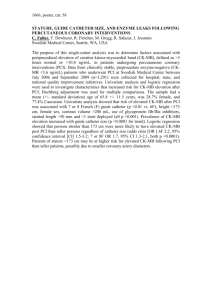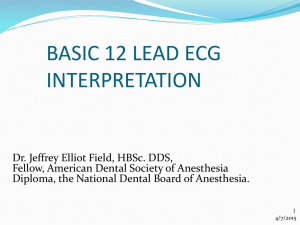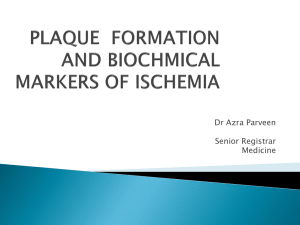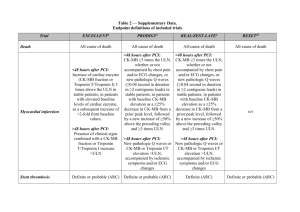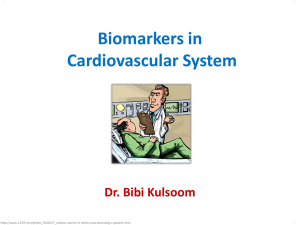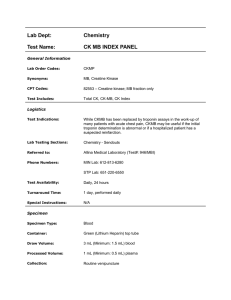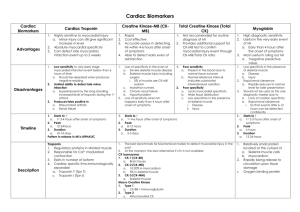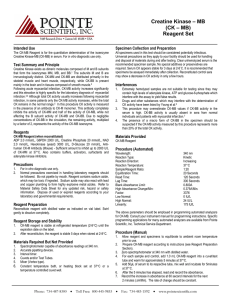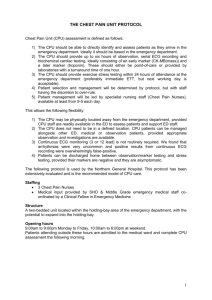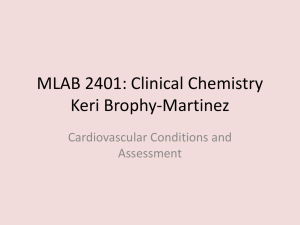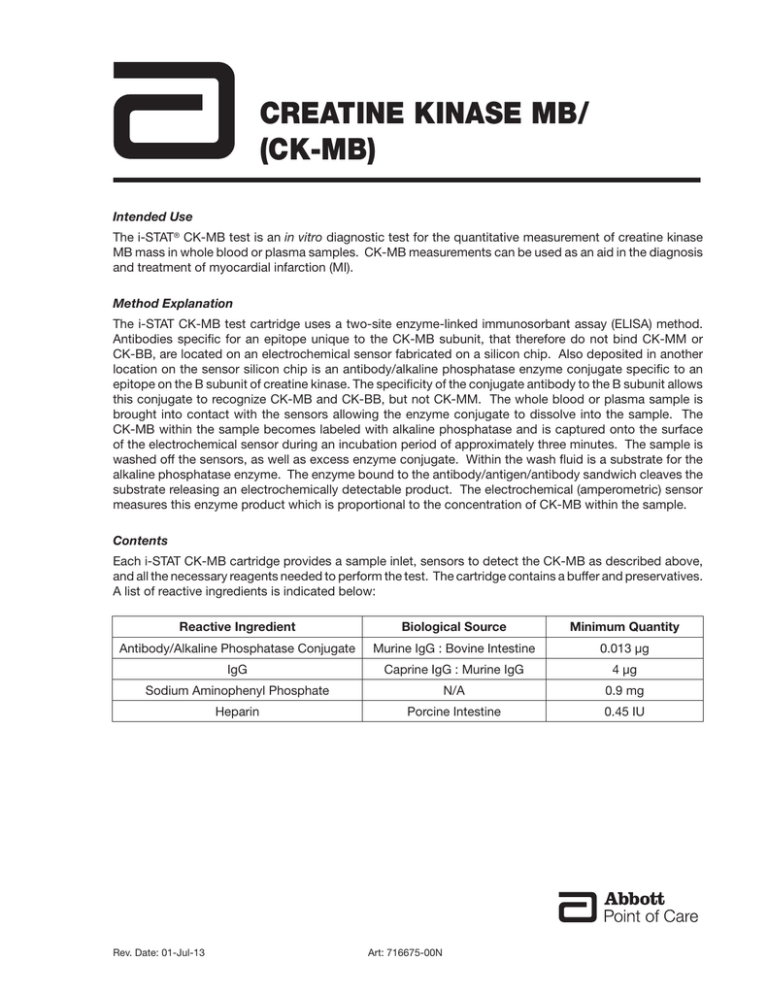
CREATINE KINASE MB/
(CK-MB)
Intended Use
The i-STAT® CK-MB test is an in vitro diagnostic test for the quantitative measurement of creatine kinase
MB mass in whole blood or plasma samples. CK-MB measurements can be used as an aid in the diagnosis
and treatment of myocardial infarction (MI).
Method Explanation
The i-STAT CK-MB test cartridge uses a two-site enzyme-linked immunosorbant assay (ELISA) method.
Antibodies specific for an epitope unique to the CK-MB subunit, that therefore do not bind CK-MM or
CK-BB, are located on an electrochemical sensor fabricated on a silicon chip. Also deposited in another
location on the sensor silicon chip is an antibody/alkaline phosphatase enzyme conjugate specific to an
epitope on the B subunit of creatine kinase. The specificity of the conjugate antibody to the B subunit allows
this conjugate to recognize CK-MB and CK-BB, but not CK-MM. The whole blood or plasma sample is
brought into contact with the sensors allowing the enzyme conjugate to dissolve into the sample. The
CK-MB within the sample becomes labeled with alkaline phosphatase and is captured onto the surface
of the electrochemical sensor during an incubation period of approximately three minutes. The sample is
washed off the sensors, as well as excess enzyme conjugate. Within the wash fluid is a substrate for the
alkaline phosphatase enzyme. The enzyme bound to the antibody/antigen/antibody sandwich cleaves the
substrate releasing an electrochemically detectable product. The electrochemical (amperometric) sensor
measures this enzyme product which is proportional to the concentration of CK-MB within the sample.
Contents
Each i-STAT CK-MB cartridge provides a sample inlet, sensors to detect the CK-MB as described above,
and all the necessary reagents needed to perform the test. The cartridge contains a buffer and preservatives.
A list of reactive ingredients is indicated below:
Reactive Ingredient
Biological Source
Minimum Quantity
Antibody/Alkaline Phosphatase Conjugate
Murine IgG : Bovine Intestine
0.013 μg
IgG
Caprine IgG : Murine IgG
4 μg
Sodium Aminophenyl Phosphate
N/A
0.9 mg
Heparin
Porcine Intestine
0.45 IU
Rev. Date: 01-Jul-13
Art: 716675-00N
Metrological Traceability
The i-STAT System test for creatine kinase-MB (CK-MB) measures creatine kinase-MB amount-ofsubstance concentration mass in plasma or the plasma fraction of venous whole blood (dimension ng/mL)
for in vitro diagnostic use. Creatine kinase-MB values assigned to i-STAT System controls are traceable
to the American Association of Clinical Chemists (AACC recombinant human CK-MB from Seradyn Inc.)
calibrator for the standardization of creatine kinase mass assays. i-STAT System controls and calibration
verification materials are validated for use only with the i-STAT System and assigned values may not be
commutable with other methods. Further information regarding metrological traceability is available from
Abbott Point of Care Inc.
Reportable Range
The i-STAT CK-MB test will report 0.0 to 150.0 ng/mL (µg/L). Samples above the reportable range will yield
“>150.0 ng/mL” on the analyzer display screen.
Reference Range
Whole blood and plasma samples from 161 apparently healthy donors were assayed in duplicate using
three different lots of i-STAT CK-MB cartridges. The 0 to 95% range of results spanned 0.0 ng/mL (µg/L)
to 3.5 ng/mL (µg/L).
Note: Each facility should establish its own reference range using the i-STAT CK-MB assay.
Clinical Significance
CK-MB mass has been reported to be useful for the diagnosis of myocardial infarction, re-infarction, and
the sizing of infarction.
For optimal diagnostic usefulness, a cardiac marker should be specific for cardiac tissue, should be rapidly
released into the bloodstream with a direct proportional relationship between the extent of myocardial
injury and the measured level of the marker, and should persist in blood for a sufficient length of time to
provide a convenient diagnostic time window.1
Creatine kinase (CK) is a dimeric enzyme found primarily in brain and muscle tissue. There are three
isoforms of creatine kinase: BB, MM, and MB. BB is found primarily in the brain. Skeletal muscles
primarily contain the MM isoform, with traces of MB (estimates of 1-4% of CK activity). Cardiac muscles
also contain primarily the MM isoform, but higher amounts of MB, typically around 20% of CK activity.2
Serum from healthy individuals typically contains the MM isoform and a small amount of the MB isoform.
CK-MB can be released into the bloodstream by a number of actions, including skeletal muscle injury and
myocardial damage.
The rise in CK-MB in the bloodstream occurs between 4-6 hours following a myocardial infarction (MI). The
concentration peaks after approximately 24-hours and returns to baseline after 36-72 hours. As the level
of CK-MB is not cardiac specific, the results of a single test are not indicative of a myocardial infarction
(MI). Typically an MI is diagnosed based on the pattern of CK-MB analyses taken at 3-hour intervals for a
6- to-9 hour period or at 6- to-8 hour intervals for a 24-hour period.
Although the cardiac-specific troponins, troponin I (cTnI) and troponin T (cTnT) are now considered the
biochemical markers of choice in the evaluation of acute coronary syndromes (ACS) including ST-elevation
myocardial infarction, non-ST-elevation myocardial infarction, and unstable angina, CK-MB can also be
used as a secondary marker to aid in the diagnosis of myocardial infarction and measuring the degree
of myocardial necrosis. Since low levels of CK-MB can be detected in the blood of healthy persons, any
CK-MB value above the 95th percentile may be indicative of some degree of myocardial necrosis.1 Each
institution should establish its own reference range for its patient population, and this range should be
used to determine an appropriate limit indicative of acute myocardial infarction (AMI).
The European Society of Cardiology / American College of Cardiology consensus document notes that in
the clinical setting of a reinfarction, CK-MB may be more useful for monitoring for MI than cardiac troponin
I (cTnI) or cardiac troponin T (cTnT) because CK-MB remains increased for only 2-4 days following an MI,
CK-MB - 2
Art: 716675-00N
Rev. Date: 01-Jul-13
in contrast to up to 5 days for cTnI or 10 days for cTnT.3,4,5,6,7 Clinical studies have also demonstrated a
close relationship between the extent of injury to the myocardium (infarct size) following MI and increased
serum CK-MB mass concentrations.8 Similarly, significant correlations have been observed between CKMB estimated infarct sizing and left ventricular echocardiography.8
Other conditions involving skeletal muscle damage like accidents, blunt trauma, severe burns, and extreme
exercise or myopathic disorders such as myocarditis that are not secondary to ischemic coronary artery
disease can also lead to skeletal muscle or myocardial injury and have the potential to cause elevations
in the blood concentrations of CK-MB. These conditions should be considered when interpreting results,
and the CK-MB level should be used in conjunction with clinical symptoms, signs, patient history, and
ECG changes.1,9
Performance Characteristics
Precision data were collected in multiple sites as follows: Duplicates of each control were tested daily for
a period of 20 days for each of three lots of cartridges, resulting in a total of 120 replicates. The average
statistics are presented below.
Method comparison data were collected using CLSI guideline EP9-A2.10 Venous blood samples were
collected in heparinized evacuated tubes and analyzed in duplicate on the i-STAT System. A portion of
the specimen was centrifuged and the separated plasma was analyzed in duplicate on the i-STAT System
and on the comparative method within 1 hour of collection.
Deming regression analysis11 was performed on the first replicate of each sample. In the method
comparison table, n is the number of specimens in the first data set, Sxx and Syy refer to estimates of
imprecision based on the duplicates of the comparative and the i-STAT methods, respectively. Sy.x is the
standard error of the estimate, and r is the correlation coefficient.*
Method comparisons may vary from site to site due to differences in sample handling, comparative method
calibration and other site specific variables.
Interference studies were based on CLSI guideline EP7-A.12
*The usual warning relating to the use of regression analysis is summarized here as a reminder. For any analyte, “if the data is a narrow range, the
estimate of the regression parameters are relatively imprecise and may be biased. Therefore, predictions made from estimates may be invalid”,10 The
correlation coefficient, r, can be used as a guide to assess the adequacy of the comparative method range in overcoming the problem. As a guide, the
range of data can be considered adequate if r>0.975.
Precision Data (ng/mL)
Rev. Date: 01-Jul-13
Plasma Control
Mean
SD
%CV
Level 1
5.9
0.7
11.9
Level 2
25.8
2.7
10.4
Level 3
90.1
9.0
10.0
Art: 716675-00N
CK-MB - 3
Method Comparison (ng/mL)
Abbott AxSYM
n
263
Sxx
1.84
Syy
2.66
Slope
1.01
Int’t
-0.19
Sy.x
3.98
Xmin
0.04
Xmax
224
r
0.994
Analytical Sensitivities
The sensitivity of the CK-MB method is 0.6 ng/mL, which is the lowest CK-MB level that can be distinguished
from zero. The analytical sensitivity is defined as two standard deviations associated with a zero calibrator.
The analytical sensitivity was estimated using a control material with <1 ng/mL CK-MB during a 20-day
precision study in which three separate lots of CK-MB test cartridges were tested in duplicate using a pool
of six i-STAT 1 analyzers for a total of 120 test results.
Analytical Specificity
The CK-MB method is specific for the creatine kinase MB isoenzyme. The following muscle proteins were
tested and found to have an insignificant effect on the measured CK-MB.
Crossreactant
Concentration
Percent Crossreactivity
CK-MM (skeletal)
10000 ng/mL
Not Detectable
CK-BB (brain)
100 ng/mL
Not Detectable
Recovery
The dilution linearity of the i-STAT CK-MB test was investigated using heparinized whole blood and plasma
samples derived from three separate donors. For each donor, the original CK-MB negative sample and a
CK-MB spiked sample were prepared. This process yielded three CK-MB positive whole blood samples
that were then assayed in duplicate for each of three separate i-STAT CK-MB cartridge lots. These whole
blood samples were then diluted using an equal mass of the original unspiked whole blood and assayed
in duplicate. From this whole blood data, the CK-MB recovery was calculated.
The plasma derived from these three donors was combined in equal masses and all pairwise combinations.
These combinations were then assayed in duplicate for each of three separate i-STAT CK-MB cartridge
lots. The CK-MB recovery for each pair was calculated using the average of the six results. The %
recoveries are listed in the Tables below.
CK-MB - 4
Art: 716675-00N
Rev. Date: 01-Jul-13
Whole Blood
Sample
Concentration
Diluted Concentration
(ng/mL)
(ng/mL)
% Recovery
A
73.24
40.73
108.7%
B
8.90
6.07
101.5%
C
47.74
26.91
109.3%
Sample
Concentration
Diluted Concentration
% Recovery
(ng/mL)
(ng/mL)
A
73.24
—
—
B
8.90
—
—
C
47.74
—
—
A+B
—
42.17
102.7%
B+C
—
30.85
108.9%
A+C
—
63.95
105.7%
Plasma
Test Limitations
The frequency of suppressed results is affected by atmospheric pressure. Suppressed result rates may
increase with higher elevations (decreased barometric pressure) and may become persistent if testing is
performed at more than 7500 feet above sea level. Where unavailability of results is unacceptable, i-STAT
recommends having an alternate test method available.
Samples from patients who have been exposed to animals or who have received therapeutic or diagnostic
procedures employing immunoglobulins or reagents derived from immunoglobulins may contain
antibodies, e.g., HAMA or other heterophile antibodies, which may interfere with immunoassays and
produce erroneous results.13-19 The generation of potentially interfering antibodies in response to bacterial
infections has been reported.13 While this product contains reagents that minimize the effect of these
interferents, and QC algorithms designed to detect their effects, the possibility of interference causing
erroneous results should be evaluated carefully in cases where there are inconsistencies in the clinical
information.
Partially clotted samples can result in elevated CK-MB readings above the reference range, as well as
quality check code errors. To prevent this from occurring, upon drawing the whole blood sample into
a heparinized collection tube, the sample should be inverted gently at least 10 times to ensure even
dissolution of the heparin anticoagulant.
Grossly hemolyzed samples can cause a decreased alkaline phosphatase activity, resulting in decreased
detection of CK-MB, increased assay backgrounds, and/or quality check codes.
Hematocrits in the range of 0-70% PCV have been demonstrated not to affect results. Samples with
hematocrit levels above this range have demonstrated increases in the test imprecision and quality check
codes.
The analyzer must remain on a flat surface with the display facing up during testing. Motion of the analyzer
during testing can increase the frequency of suppressed results or quality check codes. A level surface
includes running the handheld in the downloader/recharger.
Rev. Date: 01-Jul-13
Art: 716675-00N
CK-MB - 5
Interference Testing
When added to a plasma pool containing approximately 20 ng/mL of creatine kinase MB isoenzyme, the
following substances were found to have no significant effect (less than 10%) on the CK-MB method at
the concentrations indicated.
CK-MB - 6
Compound
Test Level
(μmol/L unless otherwise indicated)
Acetaminophen
1660
Allopurinol
294
Ampicillin
152
Ascorbic Acid
227
Acetyl Salicylic Acid
3330
Atenolol
37.6
Caffeine
308
Captopril
23
Chloramphenicol
155
Diclofenac
169
Digoxin
6.15
Dopamine
5.87
Enalaprilat
0.86
Erythromycin
81.6
Furosemide
181
Sodium Heparin
90 U/mL
Ibuprofen
2425
Isosorbide dinitrate
636
Methyldopa
71
Nicotine
6.2
Nifedipine
1156
Phenytoin
198
Propranolol
7.71
Salicylic Acid
4340
Theophylline
222
Verapamil
4.4
Warfarin
64.9
Art: 716675-00N
Rev. Date: 01-Jul-13
References
1. Braunwald, E, et al. ACC/AHA 2002 guideline update for the management of patients with unstable angina
and non-ST-segment elevation myocardial infarction: a report of the American College of Cardiology/
American Heart Association Task Force on Practice Guidelines (Committee on the Management of Patients
with Unstable Angina). J Am Coll Cardiol 2002, 40: 1366-1374.
2. D.W. Moss, A.R. Henderson, “Enzymes” in Tietz Textbook of Clinical Chemistry – Second Edition, C.A. Burtis
and E.R. Ashwood, eds. (Philadelphia: W.B. Saunders Company, 1994).
3. Apple FS, Murakami MA. Cardiac Troponin and Creatine Kinase MB Monitoring during In-Hospital Myocardial
Reinfarction, Clin Chem 2005, 51(2): 460-463.
4. Braunwald E, Antman EM, Beasley JW, Califf RM, Cheitlin MD, Hochman JS, et al. ACC/AHA guidelines for
the management of patients with unstable angina and non-ST-segment elevation myocardial infarction. J Am
Coll Cardiol 2000, 36: 970-1062.
5. Joint European Society of Cardiology/American College of Cardiology Committee. Myocardial infarction
defined – a consensus document of the joint European Society of Cardiology/American College of Cardiology
Committee for the redefinition of myocardial infarction. J Am Coll Cardiol 2000, 36: 959-969.
6. Jaffe AS, Ravkilde J, Roberts R, Naslund U, Apple FS, Galvani M, et al. It’s time for a change to a troponin
standard. Circulation 2000, 102: 1216-1220.
7. Newby LK, Alpert JS, Ohman EM, Thygesen K, Califf RM. Changing the diagnosis of acute myocardial
infarction: implications for practice and clinical investigations. Am Heart J 2002, 144: 957-980.
8. Apple FS, Sharkey SW, Falahati A, Murakami MA, Mitha N, Christensen D. Assessment of left ventricular
function using serum cardiac troponin I measurements following myocardial infarction. Clinica Chimica Acta
1998, 272: 59-67.
9.
A.S. Maisel, “Point-of-Care Diagnosis and Management of Myocardial Infarction and Congestive Heart
Failure” in Principles & Practice of Point-of-Care Testing, G.J. Kost, ed. (Philadelphia: Lippincott Williams &
Wilkins, 2002).
10. Clinical and Laboratory Standards Institute (CLSI). Method Comparison and Bias Estimation Using Patient
Samples; Approved Guideline – Second Edition. CLSI document EP9-A2 [ISBN 1-56238-472-4]. Clinical
and Laboratory Standards Institute, 940 West Valley Road, Suite 1400, Wayne, Pennsylvania 19087-1898,
USA 2002.
11. P.J. Cornbleet and N. Gochman, “Incorrect Least-Squares Regression Coefficients in Method-Comparison
Analysis,” Clinical Chemistry 25:3, 432 (1979).
12. Clinical and Laboratory Standards Institute (CLSI) Interference Testing in Clinical Chemistry; Approved Guideline.
CLSI document EP7-A [ISBN 1-56238-480-5]. Clinical and Laboratory Standards Institute, 940 West Valley
Road, Suite 1400, Wayne, Pennsylvania 19087-1898, USA 2002.
13. Clinical and Laboratory Standards Institute (CLSI). Immunoassay Interference by Endogenous Antibodies;
Proposed Guidelines. CLSI document I/LA30-P (ISBN 1-56238-633-6) Clinical and Laboratory Standards
Institute, 940 West Valley Road, Suite 1400, Wayne, Pennsylvania 19087-1898 USA, 2007.
14. Bjerner et al. Immunometric Assay Interference: Incidence and Prevention. Clin. Chem. 2002; 48:613.
15. Kricka, Interferences in Immunoassays - Still a Threat. Clin. Chem. 2000; 46:1037.
16. Schroff et al. Human anti-murine immunoglobulin responses in patients receiving monoclonal antibody therapy.
Cancer Res. 1985; 45:879.
17.Primus et al. “Sandwich”-type immunoassay of carcinoembryonic antigen in patients receiving murine
monoclonal antibodies for diagnosis and therapy. Clin. Chem. 1988; 34-261.
18. Nahm et al. Heteroantibody: phantom of the immunoassay. Clin. Chem. 1990; 36:829.
19. Boscato et al. Heterophilic antibodies: a problem for all immunoassays. Clin Chem. 1988; 34:27.
i-STAT is a registered trademark of the Abbott Group of Companies in various jurisdictions.
Rev. Date: 01-Jul-13
Art: 716675-00N
CK-MB - 7
Abbott Point of Care Inc.
Abbott Park, IL 60064 • USA
Emergo Europe
Molenstraat 15
2513 BH, The Hague
The Netherlands
Tel: (31)70 345 8570
Fax: (31)70 346 7299
©2013 Abbott Point of Care Inc. All rights reserved. Printed in USA.
Rev. Date: 01-Jul-13
Art: 716675-00N
CK-MB - 8

